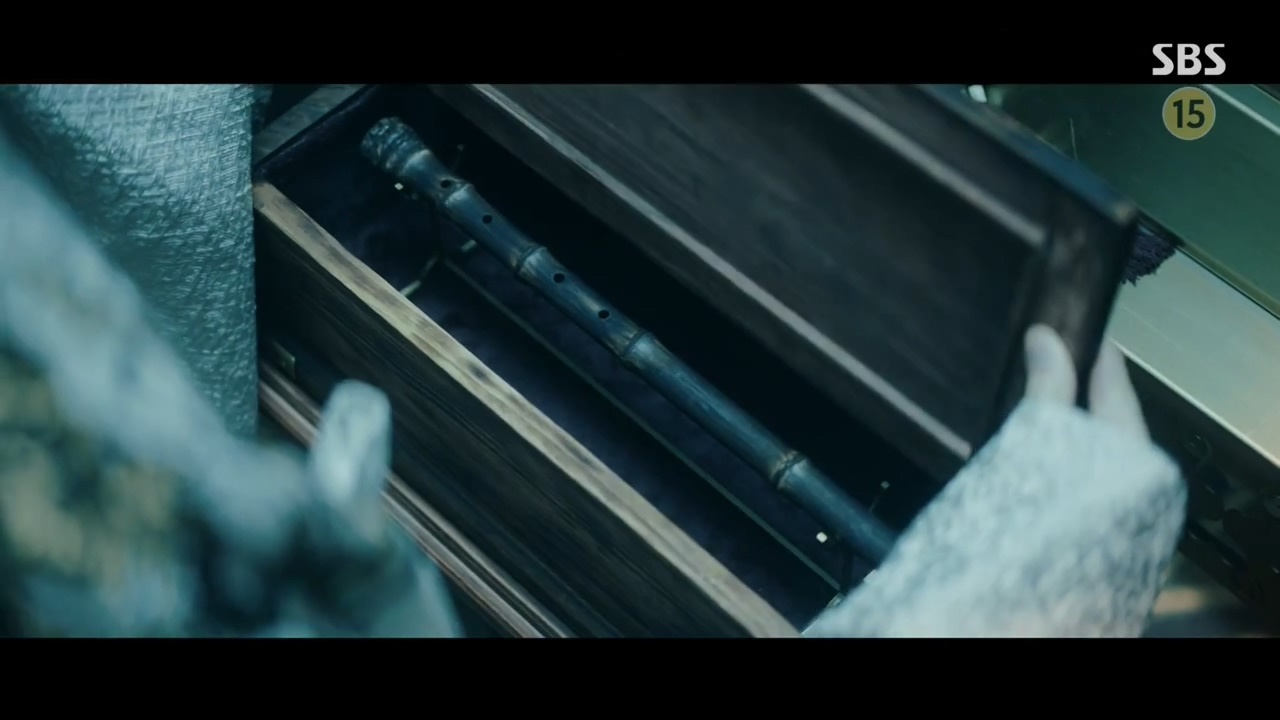

The SBS gilt drama The King: The Monarch of Eternity features the Silla treasure of the Manpa style. The instrument, which silences all waves, has been mentioned by characters since it appeared in the first episode of the drama.
The story of The King began in 1994 when the Imperial Imperial Empire broke into two. It is said that such a thing happened in the Korean Empire, which exists not only in 1994 but also now.
Lee Gon (Lee Min-ho), the prince who took half of the man-painted style in the terrible scene where his father was killed, cherished it even after he became emperor after his father. He also carries it and "shifts" to the universe where the Republic of Korea is located. The reason why he did not call it "space movement" is because his movement takes place within the same Korean peninsula.
The reason why the Manpa-style musical instrument is remembered by modern people is that the explanation of the production of the song is quite fantastic.
But, what should be remembered is that such an explanation is only fantastic for modern people, and not at all for the ancients.
Therefore, it is not necessary to dismiss the Manpasik as a legendary or narrative instrument because the explanation of
The officers (of modern countries) who record what is happening in the country are basically those affected by Western rationalism, and their schools are influenced by such cultural soils.
However, as the ancient times progressed, the officers became more and more shamanistic. According to the Jurye, which recorded the administrative system of the state before the Spring and Autumn period, the pointers (people) played the role of the cadres. The shopkeepers recorded a year of events and accidents with the aim of comparing what they predicted earlier in the year with what actually happened at the end of the year.
The fact that the officer had a shamanistic temperament also influenced their recording methods, as abstract and symbolic expressions were forced to appear in their records. And the ancients who read their records did not have to feel particularly heterogeneity, because they knew that these expressions contained abstract and symbolic meanings.
These traces remain today; when shamans present abstract and symbolic prophecies such as "the attribution will come from the East", modern people interpret them appropriately to themselves. When a person without religion loses his family, a nearby church pastor comes and comforts him, "Do not be too sad because your brother has gone to God's side." The bereaved family who do not believe in Christianity understands the meaning of the word. If religious people don’t talk like this and speak in a very realistic way, it will seem rather strange.
The
'Fantastic' Record on Manpasik
The same is true of the history of the Manpasik, which is based on the records of shamanistic officers, and the story was fantastic.
The Manpasik story in the genus is set in the era of King Shinmun (681-692), the grandson of Kim Chun-chu who destroyed Baekje along with the Tang Dynasty and the son of King Munmu who destroyed Goguryeo along with the party. It was after the temple of Gameunsaran, which commemorates his father, King Munmu, was built on the east coast of Silla.
According to the report, the king of the newspaper was reported to be 'a small mountain in the East Sea approaches the Gameunsa Temple'. So when I went out to the east coast, I found something that could be a small mountain or a small island floating in the sea, which looked like a turtle head, and there was a bamboo tree in the mountain.
The bamboo would split into two and then merge into one. When it was combined, the heavens and earth vibrated and windy. "There is a saying that the mountain is divided into day and night like bamboo, and then combined," he said.
The King of the Newspaper crossed to the island by boat with his vassal; upon his journey, there was a dragon; the King of the Newspaper asked the dragon, "What is it that this mountain splits with bamboo and then merges?" "If you say it, it is like if you hit with one hand, it does not sound, and if you hit with two hands, it sounds like it is heard," Yong said. "This bamboo is a sign that the king () will rule the world with such a sound." The monarch would rule the country with such a spirit of unity.
Then, Yong said, "If the king makes a flute with this bamboo, the whole world will be flat." "The father of the great king became a great dragon in the sea, and Kim Yusin became a god again, and the two saints sent me treasures that could not be counted like this. It was a prophecy that the world would be flattened if the bamboo sent by King Munmu and Kim Yusin made a flute.
When he returned to the palace, the king made a flute and kept it in the barn. Then miracles occurred. "If you blow this flute, the enemy will retreat and become sick, the drought will rain, the rainy season will open, the wind will stop and the waves will sink," says Samguk Yusa.
The era of the King of the Newspaper was after the collapse of Baekje and Goguryeo to secure the south of the Daedong River, but it was time for the control of the newly incorporated territory to be unstable. The Tang Dynasty, which formed the Nadang Union with the intention of monopolizing Baekje and Goguryeo lands, was shaking because of the defeat of the war with Silla and the giving of Baekje and part of Goguryeo. The royal family of Silla could not slow down the tension, as the Tang Dynasty of its allies betrayed the situation in which it cannot help but care about the trends of the people of Goguryeo and Baekje.
In this situation, the Shin Mun-wang regime designated the universal as a national treasure, promoting the above stories to the people. Through such a process, it promoted the people to have the universality.
The reason why Shin Mun-wang did so is understandable without difficulty. The combination of bamboo bamboo and bamboo as a symbol of the regime reflects the political challenges of the time when Goguryeo, Baekje Yumin and Silla people had to be united to create a new identity.
The story of the Manpa-style contains another task of unity besides such a political task: the need for religious harmony.
The King of the Newspaper received revelations from the dragon. The dragon mentioned the heavenly god. The King of the Moon also became a dragon. In the Manpa-style story, a small mountain with dragons approaches Gameunsa Temple, and the King Munmu, who is memorialized in Gameunsa Temple, becomes a dragon. It can be seen as a message urging the harmony of traditional faith and Buddhism.
In 527, with the martyrdom of the second generation, the Silla royal family believed in Buddhism, but local forces still adhered to traditional beliefs. The Buddhist religions have become stronger over time, but traditional beliefs have not been easily diminished. The message of resolving social conflicts can also be seen as a full-fledged story.
Another message of unity can also be found in the Manpa style: King Moonmu and Kim Yusin are helping the Shinmun king regime by becoming Yongsin and Cheonsin respectively. Kim Chun-chu, the grandfather of the newspaper king, became a king on the basis of the alliance between Kim Chun-chu, a non-mainstream royal family, and Kim Yu-shin, a non-mainstream nobleman. The alliance was made by Kim Yu-shin's brother Kim Moon-hee, who married Kim Chun-chu.
In the era when women outside the royal family could not become queens due to the incestuous marriage customs in the royal family, a woman with blood became a queen, where King Munmu and King Shinmun were released. So the Silla royal family at that time had to be differentiated from the previous royal family. According to the Silla Dynasty, the Shin lines classified the queen as the king of the castle and the king of the castle from Kim Chun-chu.
As such, the royal family of Silla after Kim Chun-chu was based on the new lineage, which was based on the alliance between Kim Chun-chu and Kim Yu-shin, so that the two lines could only be united to protect the regime. That message was also included in the story.
In this way, this story contains the integration of Goguryeo, Baekje Yumin and Silla people, the integration of traditional faith and Buddhist forces, and the secrets of the Shinmun king regime and the Silla royal family who want to integrate Kim Chun-chu and Kim Yu-shin. It is a story about the desire to integrate the country called Silla, which has the possibility of division, and to steadily control the south of Daedong River.
Like the Republic of Korea, which is experiencing conflicts between the two Koreas, regions, hierarchies, and labor and management, the ancient Silla has always been concerned about national integration. The product of such anxieties was the designation of the national treasure and the creation of the story. As a result of such unity, the nation was ruled by the spirit of unity. "The enemy retreated and became sick, the drought rained, the rainy season opened, the wind stopped and the waves sank," says Samguk Yusa.
The above sentence does not mean that such things actually happened the same, but it means that the title of the king has been successfully performed because it is ruled by the spirit of the mantra.
The drama The King, which is a drama about the Korean drama, was divided into two parts in the first episode, and the drama started by breaking the Korean drama which contains the message of integration. The story of The Three Kingdoms is that the Manpa-style must be combined, so that it can make a sound that makes the world peaceful.
SBS Drama